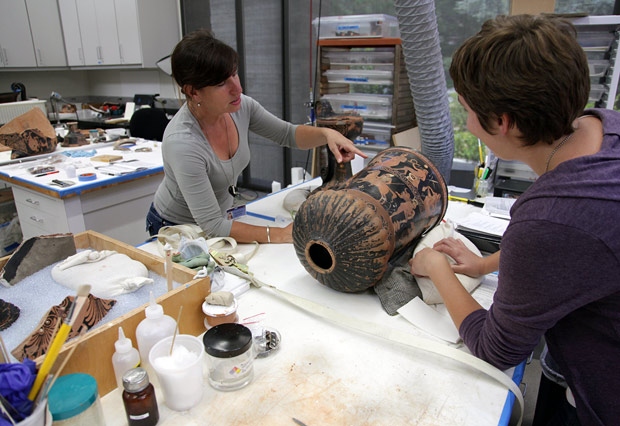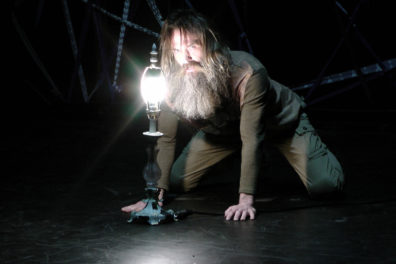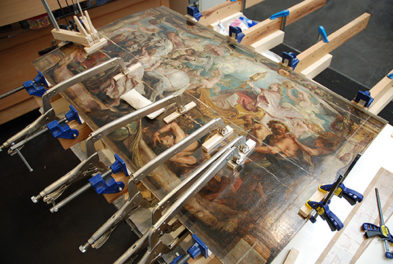Since 2008, the antiquities conservation and curatorial departments at the J. Paul Getty Museum have been working with colleagues at the Antikensammlung in Berlin to study and conserve a group of South Italian (Apulian) vases dating to the 4th century B.C. from Berlin’s collection.

Marie Svoboda and graduate intern Teresa Navarro-Gomez working with a loutrophoros from the Berlin Antikensammlung in the conservation studios at the Getty Villa
The group consists of thirteen vases, reportedly discovered in fragments in three adjoining chamber tombs at Ceglie in Southern Italy in the early 19th century. Five of the vases had already been treated in Berlin in recent years; the remaining eight were divided between Berlin and the Getty with the goal of examining and treating them in preparation for an exhibition of all thirteen vases at the Getty Villa in 2014. The four vases currently being conserved at the Getty consist of two volute kraters (mixing vessels) and two loutrophoroi (ritual vases), all of monumental size.
The project began with the study of one of the loutrophoroi, shown below. Decorated with a group of satyrs and maenads accompanying Dionysos, and a battle between Greeks and native Italians, the vase measures 1.1 meters (over 3 ½ feet) tall, including its separate lid and foot. Although ostensibly complete, even a brief visual inspection indicated that the vessel has been extensively restored after its discovery.

Loutrophoros (ritual vase), Greek (made in Italy), 300s B.C. Terracotta, 40 3/16 in. high. Antikensammlung, Staatliche Museen zu Berlin
The interior had been lined with a white, plaster-like material, which made it impossible to see breaks and missing sections from within. But when we closely studied the exterior, we saw that parts of the surface were flaking, primarily on the bottom half of the vase. This immediately raised questions. Ancient vases were not painted but rather glazed, so we should not expect to see any flaking if the surface were truly ancient.
Furthermore, in areas where the paint has been lost, the surface underneath was not the typical orangey color of ancient terracotta, but gray. These were our first positive signs that the vase had been restored—albeit expertly—after its discovery in fragments.
It became clear that we needed to employ more advanced techniques to better understand the loutrophoros’s condition and history. In an effort to reveal how much of the vase is ancient and how much is restoration, we decided to use radiography. The vase was an ideal candidate for creating a “roll-out” X-ray, since it’s an almost perfect cylinder.
To achieve a continuous X-ray, we placed the loutrophoros on a stand that slowly rotated. The X-ray film, which was cut into three adjoining strips and inserted into the vase, was exposed to X-rays only 5 millimeters at time. We achieved this by putting two sheets of lead spaced 5 millimeters apart between the X-ray tube and the vase, as shown in the photo below.

Central section of the Berlin loutrophoros being x-rayed in the antiquities conservation studios at the Getty Villa
We also inserted a lead “plug” inside the body to prevent X-rays from penetrating straight through the vase and imaging the opposite side. This setup produced one continuous X-ray with little distortion, and revealed that the bottom third of the vase had been fabricated using ceramic blanks (visible in the X-ray as the lighter areas).

X-ray of a loutrophoros from the Berlin Antikensammlung created at the antiquities conservation studios at the Getty Villa
These modern additions and their method of attachment to the original fragments were not obvious to the naked eye, because the interior of the vase had been covered with plaster and the exterior with paint.
Having identified the section that had been reconstructed, we then examined and photographed the vase using ultraviolet illumination (UV) to better understand the areas that had been overpainted (restored). Materials such as glue and paint, which would have been used by the 19th-century restorers, produce a unique visible fluorescence under UV light, whereas an untouched ancient surface should not.

The results were clear. Areas with white paint on the surface of the vase fluoresced brightly. This observation, in combination with the prominence of these white painted areas in the X-ray, led us to conclude that the added pigment is likely a modern lead white paint. An example of this can be seen with the white shield held by the warrior with a raised spear. The shield fluoresces brightly in UV and can also be seen in the X-ray. The presence of lead white paint was later confirmed by chemical analyses done by the Getty Conservation Institute (GCI).
The examination of the loutrophoros using a variety of imaging techniques has enabled us to obtain a clear—and previously unseen—view of the extent to which the vase was reconstructed. In identifying the materials and techniques that were used, we are now able to appreciate the lengths to which 19th-century restorers went in repairing fragmentary vases, and their efforts to hide evidence of their intervention.
Our discoveries have led us to adjust our original conservation plan, for this vase is not only an ancient artifact. It is also an example of 19th-century tastes and practices, and our responsibility today is to preserve that, just as much as the ancient craftsmanship.




What a wonderful article describing, in detail, the process for restoration of ancient vessels. I shall share this with my group, the Friends of Classics, San Diego State University affiliated , and we will be visiting the Villa on June 23rd to view the APHRODITE and the Gods of Love. It is quite amazing that technology has been developed to ‘see’ the history and the pattern for restoration of these pieces, so that their original integrity can be preserved.
Thank you so much for sharing this w/the public. We love visiting the Villa and look forward to the special exhibits that are relevant to our interests.
Dear Marie I hope you will be fine. I am very happy to see you after long time , when I was a student of archaeology at Harappa and you were the in-charge of laboratory there.But your work was wonderful and
very interesting , and I cannot forget your process of restoration work on ancient vessels and you.
I remember all those things and your instruction about the treatment on the ancient archaeological objects.And you gave the instruction me to do same work in Sindh Provincial Museum Hyderabd Sindh Pakistan
God bless on you
Hello,
Firstly, thank you for sharing details of this fascinating project!
I’m also contacting you to ask for information. I’m a ceramics conservator who is working on a short contract at National Museums Liverpool and one of the objects I am working on is a Loutrophoros from the Lady Lever Collection http://www.liverpoolmuseums.org.uk/ladylever/collections/antiques/index.aspx (object not shown here). I believe that what I am conserving is similar to the vessels you worked on, my observations so far have revealed that possibly only around 20% of the vessel is original. I came across your work and research and wonder if you,d be willing to share information with me..?
This is a fascinating subject and an area in which hope to do more of my own research.
Thanks in advance and I look forward to your response with any information you are willing to share.
Kind regards